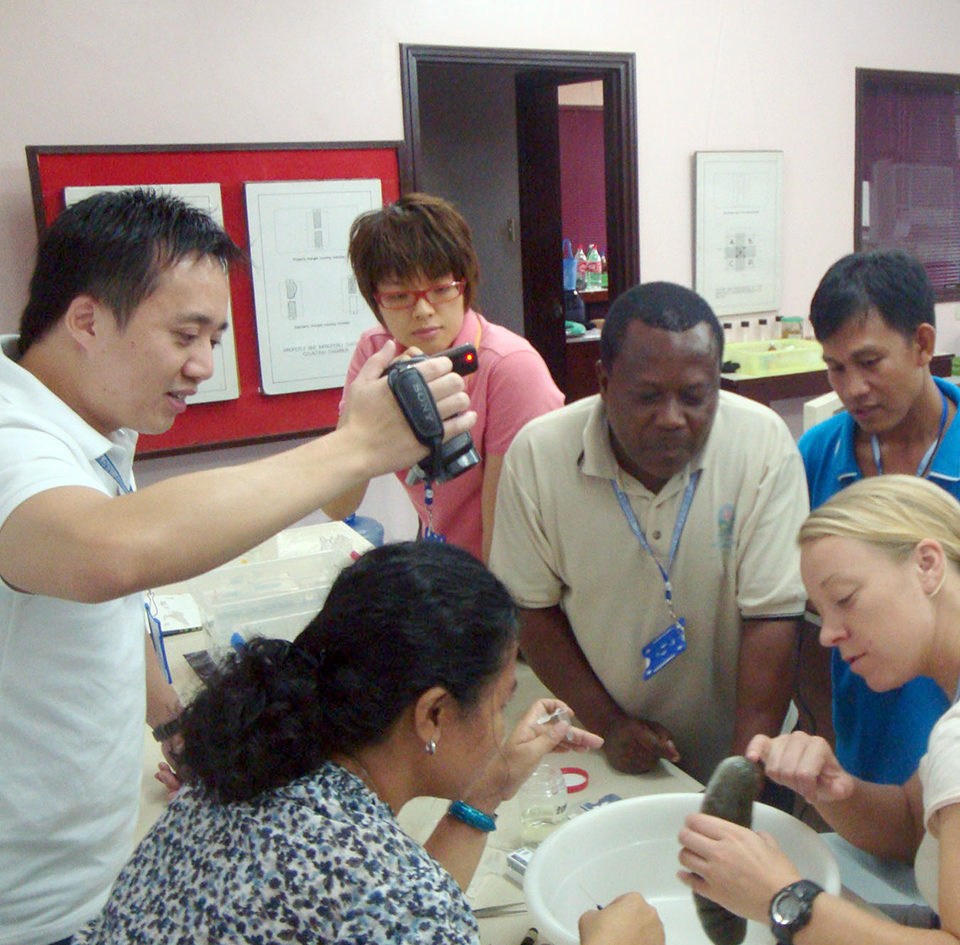Deposit-feeding detritivores can clean earthen ponds or marine cages

Lying seemingly “helpless” in the sand and gleaned quite easily by women and children in the tropics, sea cucumbers are under extreme fishing pressure. At $300-500/kg when dried, sea cucumbers (also known as “beche-de-mer”) are attractive exportable commodities mostly destined for Hong Kong, where they are valued as delicacies and ingredients in traditional medicine.
Asian and Pacific countries are the top sea cucumber producers, with the Philippines identified as a “hot spot” by the Food and Agriculture Organization prior to 2007. The region has 36 of the 52 sea cucumber species that are commercially exploited worldwide, and experts say the need for resource management is urgent.
Sandfish technologies
There is good news. The first is the development of culture technology for one of the most important, highly valued sea cucumber species, the sandfish or Holothuria scabra. Its culture was first achieved by Vietnam’s Research Institute of Aquaculture No. 3 and is now being further refined with the Southeast Asian Fisheries Development Center (SEAFDEC) in the Philippines. Collaborating partners include the University of the Philippines system, the Australian Center for International Agricultural Research through the WorldFish Center in Malaysia and the Japan International Research Center for Agricultural Sciences.
With aquaculture, fishing pressure could decrease and allow natural recruitment to play its conservation role among wild populations. In captivity, sandfish of 200 to 300 grams can be easily conditioned and then spawned by a temperature shift of about 6 degrees-C. The swimming stage of sandfish larvae can last 15 days, The settling stage runs another 30 days before the 1- to 5-mm early juveniles can be seen.
Sandfish do not need much food. In the hatchery, SEAFDEC found, they can be grown with the algae Rhodomonas, Chaetoceros, dried Spirulina species and Navicula, and some mixed diatoms when they are older.
SEAFDEC’s sea cucumber hatchery at its Iloilo station in the Philippines consists of 10, 3-cubic-meter larval-rearing tanks and four 8-cubic-meter nursery tanks that can produce sandfish juveniles in 45-day cycles. SEAFDEC’s larval-rearing trials produced more than 26,000 juveniles from eight of the tanks under operation since April. Most of this produce is used by SEAFDEC and its visiting researchers in their studies.
After the hatchery phase, nursery of sandfish can be done in tanks, hapa cages in ponds or net cages in the sea. SEAFDEC has further nursery facilities at its Igang Marine Station in the island province of Guimaras. Grow-out studies are also ongoing, mostly on polyculture with tiger shrimp; marine fishes like milkfish, sea bass, grouper and pompano; and the bivalve Anodontia philippiana.
Bioremediation
Sandfish can play a unique role in fish farming. Being deposit-feeding detritivores in shallow muddy/sandy habitats, they can be bioremediators in earthen ponds or in marine cages. Sandfish can subsist on uneaten feeds and feces excreted by cultured fish and shrimp.
Although still being studied, the combination of sandfish and sulfide-oxidizing Anodontia would be particularly useful in mariculture parks in the Philippines and elsewhere, where the two can be stocked beneath high-density milkfish cages to clean up the sediment.

Technology training
SEAFDEC has begun disseminating its sandfish hatchery and nursery technologies by opening its doors to trainees, the first of whom were from Tanzania, the United Kingdom, Malaysia and the Philippines. The first training course, conducted in October, covered sandfish biology, broodstock collection and management, natural food organisms, spawning induction, egg collection, larval rearing, nursery systems management and grow-out culture. The practical training was executed at SEAFDEC’s new sandfish hatchery and marine station.
SEAFDEC has also co-published a manual on seed production of sandfish in Vietnam with the Government of Japan Trust Fund, Vietnam’s RIA-3 and WorldFish.
Sustainable future
A “road map” for the conservation and sustainable utilization of sea cucumbers was put together by the Philippine government in late September in Manila with inputs from SEAFDEC and its partners. The road map emphasized more research and development to refine and commercialize seed production and, more importantly, the involvement of coastal communities in grow-out culture trials for stock enhancement or sea ranching as part of a holistic resource management program.
(Editor’s Note: This article was originally published in the January/February 2011 print edition of the Global Aquaculture Advocate.)
Authors
-
M.T. Castaños
Southeast Asian Fisheries Development Center
Aquaculture Department
Tigbauan, Iloilo 5021 Philippines -
R.H. Ledesma
Southeast Asian Fisheries Development Center
Aquaculture Department
Tigbauan, Iloilo 5021 Philippines -
K.G. Corre
Southeast Asian Fisheries Development Center
Aquaculture Department
Tigbauan, Iloilo 5021 Philippines -
E.G. de Jesus-Ayson
Southeast Asian Fisheries Development Center
Aquaculture Department
Tigbauan, Iloilo 5021 Philippines
Tagged With
Related Posts

Responsibility
Sea cucumber project redefining traditional farming in Madagascar
Farming sea cucumbers – known as sea slugs in China – is changing people’s lives, giving rural workers in Madagascar a potential pathway out of poverty.

Health & Welfare
Probiotics improve nursery performance of juvenile sea cucumbers
While sea cucumbers are one of the most prized seafoods in China and Asia, their production suffers from suboptimal juvenile production. The use of proper feeds and overall management in the nursery can improve yield and survival.

Innovation & Investment
Aquaculture in Canada: status, perspectives
Canada exports farmed seafood products to more than 22 countries and is the main seafood supplier to the U.S. market. Finfish, primarily salmon, production is strong and shellfish production is growing, but diversification will be imperative to maintain competitiveness.

Innovation & Investment
Eye in the sky: Europe employs satellites to advance aquaculture
Copernicus – the European Space Agency’s €4.3 billion Earth Observation System – holds potential benefits for fisheries and aquaculture. The SAFI project is approaching the aquaculture sector about harnessing, and montetizing, this unique service from up above.


